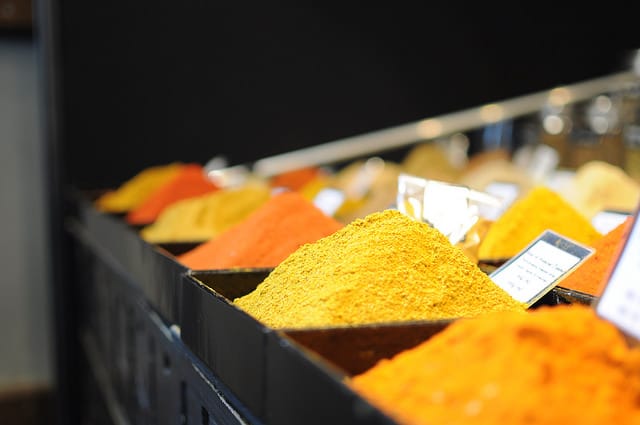
By Dr. Kathy Boehme
Spices have been used for thousands of years by various cultures around the world, but did you know they can be helpful for pets, too? Ask your vet how adding fresh supplements — like these warming spices — into your pet’s diet can boost his/her health.
Ginger
- Warming
- Pungent taste
History: Legend has it that Confucius chewed on a small piece of fresh ginger after each meal and attributed much of his longevity to it.
Benefits: Ginger enhances the appetite, increases mucus production in the mouth and stomach, speeds up the release of digestive enzymes and helps with chemotherapy or motion-induced nausea. It has both antibacterial and anti-cancer properties and powerful antioxidant activity. It also helps lower blood sugar.
Ginger disperses cold in the chest and helps stop coughing by eliminating phlegm stagnation. It “releases the exterior” to expel pathogens, which is seen physiologically as sweating.
Like all warming foods, ginger is especially helpful for geriatric conditions or as a general health booster during cold weather. It may be added to a home cooked diet, but is most commonly used in a formulated supplement for medicinal purposes.
Tangerine peel
- Warming
- Bitter taste
History: One folk tale claims the benefits of tangerine were found accidently when tangerine flowers fell into a powerful governor’s tea. The governor found that his chronic cough improved soon after drinking the tea. Later it was discovered that the peel had an even greater effect on his bronchitis.
Benefits: Tangerine peel helps move Qi stagnation associated with digestion and relieve indigestion. It facilitates the movement of Qi from the stomach, thereby helping the smooth flow of lung Qi. This helps to relieve coughing. Any citrus peel helps the flow of Qi through the middle of the torso.

From a Western standpoint, it dilates blood vessels, increases peristalsis (muscle contractions that move food through the digestive tract) and acts as an anti-inflammatory.
Tangerine peel also contains antioxidants and phytochemicals that may prevent cancer and enhance the effectiveness of Vitamin C within the body.
While it is most commonly found in a formulated supplement, tangerine peel can also be used in a tea that may be added to a home cooked or commercial diet.
Cinnamon twig
- Warming
- Sweet taste
History: Early cultures used cinnamon twigs for everything from treating wounds and fungal infections on the skin to dispelling indigestion.
Benefits: Cinnamon facilitates the flow of Qi through the blood vessels, thereby helping relieve blood stagnation. It warms the blood and releases the exterior by promoting sweating. This can help lower body temperature during a fever.
Cinnamon has both antiviral and antibiotic properties. As a mild diuretic, it also promotes urination.
In Western medicine, cinnamon has been used to help stabilize blood sugar for type 1 and type 2 diabetes and as an appetite stimulant. In addition, it helps relieve flatulence and acts as an anti-spasmodic for muscle cramps.
Cinnamon is a great option for older animals. It may be used as a supplement or to spice home cooked food in the winter for a warming effect.
Cardamom
- Warming
- Pungent taste
History: It is said that Alexander the Great first brought cardamom back from India. It is used extensively in some European countries for the prevention and treatment of indigestion.
Benefits: Cardamom increases movement of the stomach and decreases nausea. It can be used for constipation, diarrhea or indigestion. Cardamom helps digestion by draining dampness from the body. It also induces perspiration. Cardamom contains powerful antioxidants as well as anti-cancer phytochemicals.

Photo Credit
Curcumin
- Warming
- Bitter taste
History: Curcumin is a substance found in turmeric, which has been used for thousands of years in India to treat various stomach and liver issues. It has also been used topically for its antimicrobial properties.
Benefits: Curcumin invigorates blood and Qi circulation and helps resolve stasis and pain. It helps prevent indigestion by reducing gas and bloating. It has both antibiotic and anti-cancer properties and can be used as a disinfectant on wounds.
Curcumin lowers two pro-inflammatory substances known as LOX and COX-2. This not only helps relieve painful joints, but may also protect the cardiovascular system by preventing plaque buildup in the blood vessels.
Because it is poorly absorbed, culinary turmeric is not ideal for medicinal use but can still be used to flavor food and impart a rich golden color. More bioavailable forms, such as Cur-OST SA Pure, can be used for medicinal purposes.
Mint
- Cooling
- Pungent taste
History: Mint was thought to be brought to the New World by the pilgrims.
Benefits: Mint was included here because it can be tremendously cooling and soothing during an acute viral infection characterized by a headache and sore throat. It disperses heat, clears the head, eyes and throat and moves Qi upward and outward through the abdomen, particularly the liver. It also has anti-inflammatory properties and may help lower a fever.
Mint may also be used in a tea during the warmer months to help cool the body.
As with all over-the-counter supplements, the medicinal forms of these spices are not regulated by the FDA. Use caution and research before you buy. The culinary forms can certainly be used to spice up food and in some cases, may have beneficial medicinal value.
Dr. Kathy Boehme is a partner at The Drake Center for Veterinary Care in Encinitas, CA. If you would like to schedule an Integrative Appointment with her, go here.

